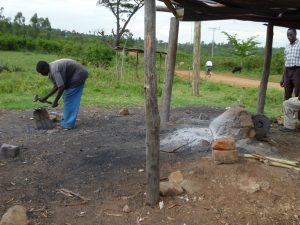
Today Michael takes me to his village, Kager, to view the Achungo farm plots. The farming now takes up a lot of Michael’s time and is our key to moving toward some level of self-sufficiency. The current Samaritan’s Purse funding (the only funded project going on right now) provides for the costs for these plots with the objective of providing the majority of the food for the children and staff of Achungo.
There are 5 plots, 2 are on a hill, today we walk the 3 that are in the lowland. Michael and 6 hired hands cultivated the plots and seeded and fertilized maize and beans some 3 weeks prior and the corn is more than knee high. They’ve been weeding it, as grass and weeds grow very fast during the rainy season, and are now applying fertilizer topically (“top-dressing”) as a second application. They’ve dug ditches through the fields to carry away rain runoff that otherwise would wash out the crop. Their methods have resulted in fields that look far more productive (denser and in better health) than neighboring fields.

Afterward, Michael takes me back to his family compound – where he grew up and where some of his family still live. Families in rural Kenya that have any land build their homes in clusters that kind of radiate out from the parents hut. We passed the house of one of Michael’s brothers and he called a greeting over the bleating of his several young goats. Further up we entered the family’s main area where Michael’s house sits next to his mother’s and his grandmother’s. Once small mud huts, they are now stuccoed, 3-room homes with tin roofs (as opposed to thatch). It is an idyllic setting, with large, open areas of verdant wild grass that looks like a well-kept lawn and many shade and fruit trees. The mango tree was full of fruit that would be ripe in another month and behind the houses was a small stand of banana trees.
After we greet his mother (his grandmother is not at home), we greet Beatrice, who was outside washing clothes in a large bucket. Michael invites me inside for lunch and we talk as Beatrice prepares and serves a lunch of rice and chicken.

We talk about the farming and then about other ways we might develop projects to help with food or provide some self-funding. After lunch, Michael invites his oldest brother to talk to us about various cash crops that he might suggest. He also invites over an “mzee”, an older neighbor who has been chicken farming, to talk to us about his methods, costs and market prices. Finally, we end our agri-project ruminations by visiting a nearby greenhouse funded by an American group and viewing its impressive vegetables.
On our way back to Rodi, Michael stops at the “village blacksmith” and we watch a while as he hammers iron hoe blades. His forge (coal fire-pit) has a people-powered blower (hooked up to a bike wheel with a handle for manual turning). I had noticed the metal plow sitting in Michael’s yard — with a team of oxen, he had gotten very familiar with that plow just a month prior. I could imagine that it came from that same local smithy, his forge and his hammer.
